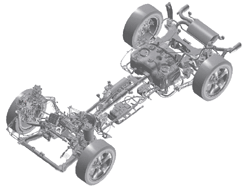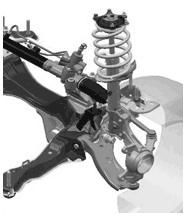CHASSIS
A challenging and varied urban driving landscape steered development of the RDX chassis. In an urban driving environment, the ability to accelerate, turn and brake quickly - with stability and control - are essential capabilities. But the RDX was also designed to excel on wide-open highways, sweeping mountain roads, and long stretches of Interstate.
The design goal for the RDX chassis was to provide the sporty handling of the Acura TSX sports sedan with the versatility of an SUV. These difficult goals for dynamic performance were not easy to achieve because the RDX needed to provide a high eye-point (seating position) to provide the driver and passenger's better visibility in urban traffic conditions. And the higher the center of gravity a vehicle has, the more difficult it is to provide responsive and nimble handling like a sports sedan.
 Acura designers answered this challenge by giving the RDX a low center of gravity, SH-AWD™ for superb cornering capability (see the Powertrain section), and overall chassis specifications rivaling those of a sports sedan. The result is an especially confident experience when changing lanes or cornering.
Acura designers answered this challenge by giving the RDX a low center of gravity, SH-AWD™ for superb cornering capability (see the Powertrain section), and overall chassis specifications rivaling those of a sports sedan. The result is an especially confident experience when changing lanes or cornering.
Acura RDX Chassis Goals includes:
- Responsive steering
- A "Sports AWD" ride and handling
- High dynamic performance
- Low Noise, Vibration and Harshness (NVH)
BEST-IN-CLASS CORNERING
The RDX achieves its mission to provide sports sedan handling, and one-ups its rivals. When tested on the skid pad, Acura internal measurements show the RDX achieves a maximum cornering force of 0.85g. This exceeds the cornering performance of the BMW X3 in the same test conditions. Much of the credit for the RDX's cornering performance goes to the SH-AWD™ system (see the Powertrain section). As a result, the RDX provides sharp steering through intersections, direct and linear response on winding roads, and high speed stability on highway.
SUSPENSION
Acura engineers wanted to create a vehicle that transcended the traditional SUV driving experience. So rather than target SUV driving characteristics, they benchmarked the dynamic characteristics of the Acura TSX. As a result, the RDX is at the top of its class for acceleration, turning and stopping, while delivering excellent ride quality. The SH-AWD™ system plays an important part in this, but so does the 4-wheel independent suspension, which provides crisp, compliant handling in the city and confident handling on the highway.
 Front Suspension
Front Suspension
The RDX front suspension is a specially designed and tuned MacPherson strut arrangement with compact packaging, ride comfort, and the long wheel travel and ruggedness necessary to meet harsh urban roads. The geometry has been optimized with both a high caster angle and "trail," to provide sharp on-center steering response and stability.
Additional specifics of the front suspension that help achieve sports sedan-like handling include:
- High-friction upper strut mount provides a good on-center steering feel, along with increased linearity while reducing steering shimmy
- Asymmetrical coil springs improve steering quality
- Large-diameter lower arm compliance bushing reduces NVH
- Optimized kingpin layout enhances steering feel and linearity
- Large-diameter steering gearbox with rigid bushings adds stiffness and improves linear steer feel
- 21mm front stabilizer bar helps control body roll for flatter cornering
REAR SUSPENSION
 An independent multi-link rear suspension system with aluminum knuckle fits compactly underneath the rear seating and storage areas while providing excellent ride and handling characteristics, with low NVH. The suspension uses large-diameter trailing arm bushings to reduce harshness and improve ride comfort. A special steel suspension subframe with large "floating" bushings markedly reduces NVH while maintaining stability. Front and rear stays increase the subframe mounting point rigidity, improving stability and steer feel.
An independent multi-link rear suspension system with aluminum knuckle fits compactly underneath the rear seating and storage areas while providing excellent ride and handling characteristics, with low NVH. The suspension uses large-diameter trailing arm bushings to reduce harshness and improve ride comfort. A special steel suspension subframe with large "floating" bushings markedly reduces NVH while maintaining stability. Front and rear stays increase the subframe mounting point rigidity, improving stability and steer feel.
Rear suspension features:
- Anti-squat geometry to reduce pitching under acceleration
- 19mm rear stabilizer bar contributes to flatter cornering
STEERING
The Acura RDX has quick-ratio (15.1:1) power rack-and-pinion steering for steering response like that of a sports sedan. The hydraulically assisted steering is engine-speed sensing, for easy maneuvering at low speeds and maximum feel and driving enjoyment at higher speeds. The turning diameter is 39.2 feet, curb to curb.
To improve steering precision, a stay (or stiffener) supports each end of the steering rack, further improving steering rigidity. In addition, the rack-and-pinion gearbox has aluminum mounting brackets. When a severe crash occurs these aluminum brackets are designed to break off when the engine is pushed rearward into the rack-and-pinion gearbox. This helps reduce intrusion into the interior.
WHEELS & TIRES
The RDX is the first Acura with standard 18-inch wheels and tires. RDX comes with 18x7.5-inch aluminum alloy wheels paired with Michelin P235/55R18 99V high-performance all-season tires. These high-performance all-season tires are exclusively designed for the RDX, and have optimized sidewall rigidity that maintains vehicle stability in all load conditions. The low-profile tires also provide top class traction and braking in all weather conditions. In addition, an optional dealer-installed 19-inch wheel and tire package is available.
4-WHEEL DISC BRAKES
RDX features 4-wheel disc brakes, 11.7-inch diameter brake rotors in front and 12.0-inch diameter rotors in the rear. Besides providing highly fade-resistant performance, the RDX brake system has a firm pedal feel with linear response.
An Anti-lock Braking System (ABS) with Electronic Brake force Distribution (EBD) is standard on the RDX. ABS helps the driver retain steering control during hard braking. EBD automatically proportions brake power to the rear brakes according to the vehicle load and driving conditions, improving stopping performance.
The RDX also has brake assist, which uses a microprocessor that recognizes the driver's intention to quickly and forcefully apply the brakes in a panic stop situation. In this case, Brake Assist immediately supplements the braking force, enabling the best braking performance in the moment when it's most needed. Brake Assist only supplements the driver's intentions, and its function terminates immediately when the driver releases the brake pedal.
VEHICLE STABILITY ASSIST WITH TRACTION CONTROL
Vehicle Stability Assist™ (VSA®) is included as standard equipment. By continually monitoring the vehicle's operating parameters (such as vehicle speed, throttle position, steering angle, individual wheel speeds, lateral g, and yaw rate), VSA® detects if the vehicle is about to oversteer or understeer. To help correct either of these situations, 4-channel VSA®
automatically reduces the engine's torque output as needed, and applies one or more brakes individually, to help stabilize the chassis. The response is so quick that the instability may be corrected even before the driver knows it's occurring. Traction Control is integrated into the VSA® and in cooperation with SH-AWD™ helps the RDX accelerate smoothly on slippery surfaces.
TIRE PRESSURE MONITORING SYSTEM
Acura RDX has an onboard Tire Pressure Monitoring System (TPMS) that warns the driver if the air pressure decreases significantly in any tire. The system helps reduce the chance of damaging a tire or losing control of the vehicle due to low air pressure. This is important because a slow leak, such as one that might be caused by a nail or road debris, might not be easily detectable but could cause significant air loss, loss of grip and potentially a blowout.
TPMS uses a sensor mounted on each wheel that continually monitors tire pressure and sends a coded signal to the TPMS electronic control unit (ECU). The process begins with a signal initiator located inboard of each tire on the chassis. The initiator sends a unique signal for each TPMS sensor. Then the TPMS sensor sends tire pressure data to the TPMS ECU, which compares the values for each tire's pressure against an acceptable range of pressures.
On the RDX the Multi-Information Display (MID) shows the location of the tire with significant pressure loss.
On the RDX with Technology Package the system can also display the air pressure in all four tires simultaneously via the MID, making it simple to locate a low-pressure tire.
FUEL TANK AND DRIVING RANGE
The RDX's large 18-gallon fuel tank is located in a protected position under the body and forward of the rear wheels. Based on Acura's estimated combined fuel economy of 19 mpg, the RDX can cover over 340 miles on one tank of fuel.
1,500-POUND TOW RATING
For added utility, the RDX has a 1,500-pound tow rating when equipped with the available towing package. The tow rating makes the RDX capable of pulling a small camping trailer, personal watercraft or motorcycle trailer.
RDX EXTERIOR ACCESSORIES
A wide range of exterior accessories have been developed for the Acura RDX. Because of this simultaneous engineering, the accessories are guaranteed to fit right, work right, and have the lasting durability and value that Acura customers expect. When selected at the time of vehicle purchase, they are also covered by Acura's 4-year/50,000-miles basic warranty.
- Front spoiler
- Rear diffuser
- Sport running boards
- Full nose mask
- Splash guards
- Hood air deflector
- Roof rack
- Body Side Molding (color matched)
- 19-inch aluminum alloy wheels
- Class 1 towing package (1,500 lbs.)
- Moonroof visor
- Back-up sensors (color matched)
- Rear bumper appliqué
- Gold emblems
- Wheel locks
ECOLOGY
Like all products from Honda of America Manufacturing's facility in Marysville, Ohio, the RDX follows strict guidelines for environmental care - both in manufacturing and in the actual vehicle components. Following is a partial list of significant environmental processes used in creating the RDX and reducing its long-term environmental impact.
- More than 90-percent of RDX component parts are made of recyclable materials
- The use of non-chromed tanned leather in leather-equipped models reduces hazardous waste generation during the tanning process, and can be composted at the end of the vehicle's life
- Elimination of PVC material in most interior parts (door lining, seat trim, shift knob, etc.) and exterior parts (roof and door moldings, weather strips and tubes) improves with recycling
- Halogen is eliminated from fire-retardant materials, and wheel balance weights and electro-deposition paints contain no lead
- Use of molded-in color plastics reduces paint use and factory emissions
- Replacement of ABS plastic with polypropylene material in the center console, instrument panel and doors reduces emissions during plastic manufacturing